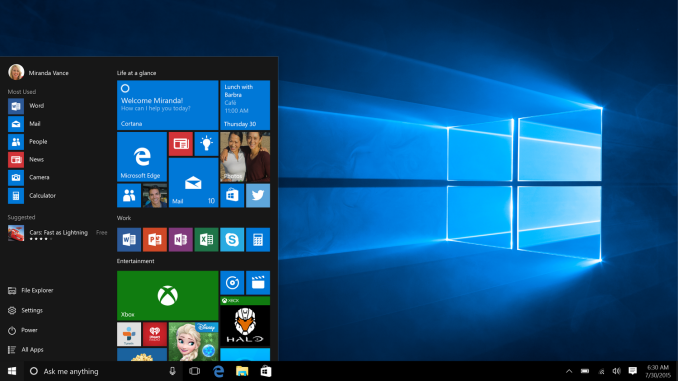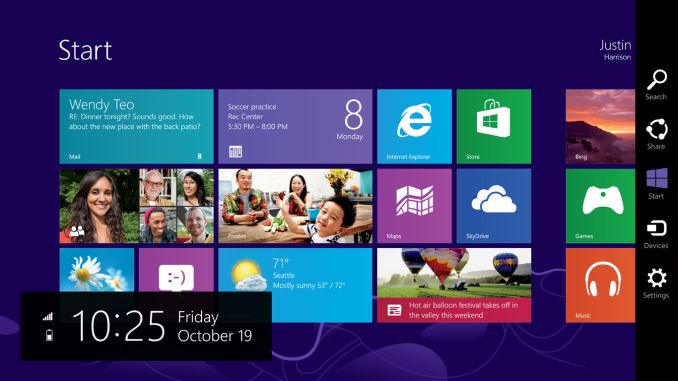The Windows 10 Review: The Old & New Face of Windows
by Brett Howse on August 25, 2015 8:00 AM EST- Posted in
- Operating Systems
- Microsoft
- Windows 10

Let’s flash back to 2012. About three years ago, Windows 8, the last major release of Microsoft’s ubiquitous operating system, was released to manufacturers. This was to be Microsoft’s most ambitious release yet. Traditional PC sales were in decline, and more personal devices such as the iPad tablet were poised to end the dominant PC platform. Microsoft’s response to this was to change Windows more than in any previous release, in a bid to make it usable with the tablet form factor. Windows 8 launched in October 2012 to much fanfare.
There was much fanfare, but little in the way of sales. Yes, Microsoft did sell many copies of Windows 8, but it did not help the declining PC market rebound. Windows 8 came to be with a touch first interface, with a new Start Screen replacing the traditional Start Menu, and a new breed of Windows 8 apps, which run on the WinRT framework. These WinRT apps have been named many things over the past three years, starting with Metro apps. A trademark dispute ended that naming scheme though, and over time they have morphed from full screen apps to universal apps to Windows Store apps, and practically none of them were able to rival the older Win32 platform in popularity or productivity.
Windows 8 did bring some great features to Windows, but they were overshadowed by the major design shift which, while good as a touch based operating system, alienated many who still used Windows on a traditional desktop or notebook. The Start Screen was a big turn off to many people, and full screen apps were not very efficient on a large screen display. Even the multitasking in Windows 8 was less than ideal, with the initial release only allowing two Windows Store apps to be open at any one time, and the second was relegated to a small side bar.
Microsoft’s own faith in Windows 8 was clearly not strong. Only a couple of weeks after Windows 8 launched, they unceremoniously dumped the project head Steven Sinofsky from the company, and spent the next two years trying to make Windows 8 more usable on traditional mouse and keyboard type machines, which were the vast majority of Windows devices in the hands of users. Windows 8.1 arrived and fixed some of the key issues with Windows 8, and 8.1 Update launched with the ability to boot to the desktop, and avoid the touch interface almost completely if you wanted to.
 Windows 10 Start Menu and Desktop view
Windows 10 Start Menu and Desktop view
When looking at Windows 10, I think it is pretty important to look back over the last three years, because none of this is ever built or designed in a vacuum. Microsoft has a huge number of devices running Windows, but a large majority of them are running Windows 7, which was an evolutionary desktop upgrade. Windows 8 struggled to ever take over any of that usage share. Windows 10 is Microsoft’s attempt to bridge the divide. Windows 7 is used by hundreds of millions of people, but its touch support is practically zero. Windows 8 works well in a touch scenario, but is not ideal for keyboard and mouse based devices. Windows 10 promises to be the version of Windows which bridges this gap.
Windows 10 brings about as much change as Windows 8 did, but in almost all cases it is going to be appreciated by users rather than avoided. It will run on a dizzying number of device types, including the traditional desktop, notebook, tablet, two-in-one, phone, IoT, Raspberry Pi, Hololens, Surface Hub, and even Xbox One. What it will bring to each of those device types is not the single interface that Windows 8 pushed on the desktop, but a unified app platform. Each device type will have its own interface, but the underlying app platform will allow developers to target a huge number of devices. And developer buy-in is the one thing Microsoft needs more than any other in order to make this vision succeed. For all of Windows 8’s quirks, it was really the lack of quality apps in the Windows Store which was the one hurdle Microsoft could not code around. Only time will tell whether or not the new model succeeds where the old one failed, but at the beginning of the life of Windows 10 we can go through all aspects of it and see what’s new, what’s changed, and how it fits in on today’s devices.











293 Comments
View All Comments
Brett Howse - Tuesday, August 25, 2015 - link
So, I did try cursive. I found out two things. The ability for it to recognize words correctly is even more astounding, and my cursive is even worse than my handwriting. It did seem to handle the small amount of cursive I could remember how to write, but I think on this one YMMV. Best to try it out in a store if you can.chrome_slinky - Wednesday, August 26, 2015 - link
For most of us, handwriting IS cursive, and printing is printing.keg504 - Tuesday, August 25, 2015 - link
I understand in context that when you say screen diameter you mean the diagonal length of the screen, but your use makes me wonder if we'll ever see a round Windows 10 deviceBrett Howse - Tuesday, August 25, 2015 - link
For those commenting on the privacy concerns with Windows 10, I have updated the privacy page (page 18). Microsoft has a FAQ which goes over every single setting in Windows 10, what it is used for, and how to disable it.Oxford Guy - Tuesday, August 25, 2015 - link
And how Microsoft will ignore some of these settings and still send data to itself?Brett Howse - Wednesday, August 26, 2015 - link
Yes actually.As you use Windows, we collect performance and usage information that helps us identify and troubleshoot problems as well as improve our products and services. We recommend that you select Full for this setting.
•Basic information is data that is vital to the operation of Windows. This data helps keep Windows and apps running properly by letting Microsoft know the capabilities of your device, what is installed, and whether Windows is operating correctly. This option also turns on basic error reporting back to Microsoft. If you select this option, we’ll be able to provide updates to Windows (through Windows Update, including malicious software protection by the Malicious Software Removal Tool), but some apps and features may not work correctly or at all.
Enhanced data includes all Basic data plus data about how you use Windows, such as how frequently or how long you use certain features or apps and which apps you use most often. This option also lets us collect enhanced diagnostic information, such as the memory state of your device when a system or app crash occurs, as well as measure reliability of devices, the operating system, and apps. If you select this option, we’ll be able to provide you with an enhanced and personalized Windows experience.
•Full data includes all Basic and Enhanced data, and also turns on advanced diagnostic features that collect additional data from your device, such as system files or memory snapshots, which may unintentionally include parts of a document you were working on when a problem occurred. This information helps us further troubleshoot and fix problems. If an error report contains personal data, we won’t use that information to identify, contact, or target advertising to you. This is the recommended option for the best Windows experience and the most effective troubleshooting.
nwoghost - Tuesday, August 25, 2015 - link
Great review. I've been waiting for this...now I feel I can upgrade with full consent haha.xebico - Tuesday, August 25, 2015 - link
Nice overview of what Windows 10 begins to the table, but I'll still buy you a beer to refresh your memory about the difference between "that" and "which." ;)MarekZe - Tuesday, August 25, 2015 - link
All parents: Windows 10 totally dropped Parental Control.There is no way to setup restrictions for apps or times that kids are allowed to use the computer without creating "Microsoft Account" (btw- how it is COPPA compliant? ) - so with local account no way to use parental control.
So you have to create Microsoft account - that means you need to provide email address for your kid, and needlesly pass PII info to Microsoft, add family members to "Family" and do rudimentary setup in web application.
Even if you do that you can't set up time schedule for computer usage - something that worked very well in Windows 7.
Big step backwards in usability and features.
Deelron - Tuesday, August 25, 2015 - link
It's "ok" since you can get a weekly email of their activity by default...https://boingboing.net/2015/08/10/windows-10.html